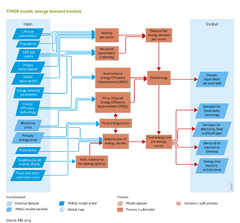Energy demand: Difference between revisions
Jump to navigation
Jump to search
m (Text replace - "MainComponent" to "AggregatedComponent") |
m (Text replace - "Drivers" to "Scenario drivers") |
||
| Line 4: | Line 4: | ||
|FrameworkElementType=pressure component | |FrameworkElementType=pressure component | ||
|Status=Publishable | |Status=Publishable | ||
|IMAGEComponent=Energy supply and demand; Energy conversion; Energy supply; | |IMAGEComponent=Energy supply and demand; Energy conversion; Energy supply; Scenario drivers; Human development; Forest management; | ||
|KeyReference=Daioglou et al., 2012; Girod et al., 2012; Van Ruijven et al., 2012; | |KeyReference=Daioglou et al., 2012; Girod et al., 2012; Van Ruijven et al., 2012; | ||
|InputVar=GDP per capita; Value added; Private consumption; Population per Region; Energy intensity parameters; Energy efficiency technology; Exogenous market shares; Primary energy price; Electricity price; Lifestyle parameters; | |InputVar=GDP per capita; Value added; Private consumption; Population per Region; Energy intensity parameters; Energy efficiency technology; Exogenous market shares; Primary energy price; Electricity price; Lifestyle parameters; | ||
Revision as of 17:28, 11 December 2013
| Component is implemented in: |
|
| Related IMAGE components |
| Projects/Applications |
| Key publications |
Key policy issues
- How will energy demand evolve particularly in emerging and medium- and low-income economies?
- What is the mix of end-use energy carriers to meet future energy demand?
- How can energy efficiency contribute to reducing the growth rate of energy demand and mitigate pressures on the global environment?
